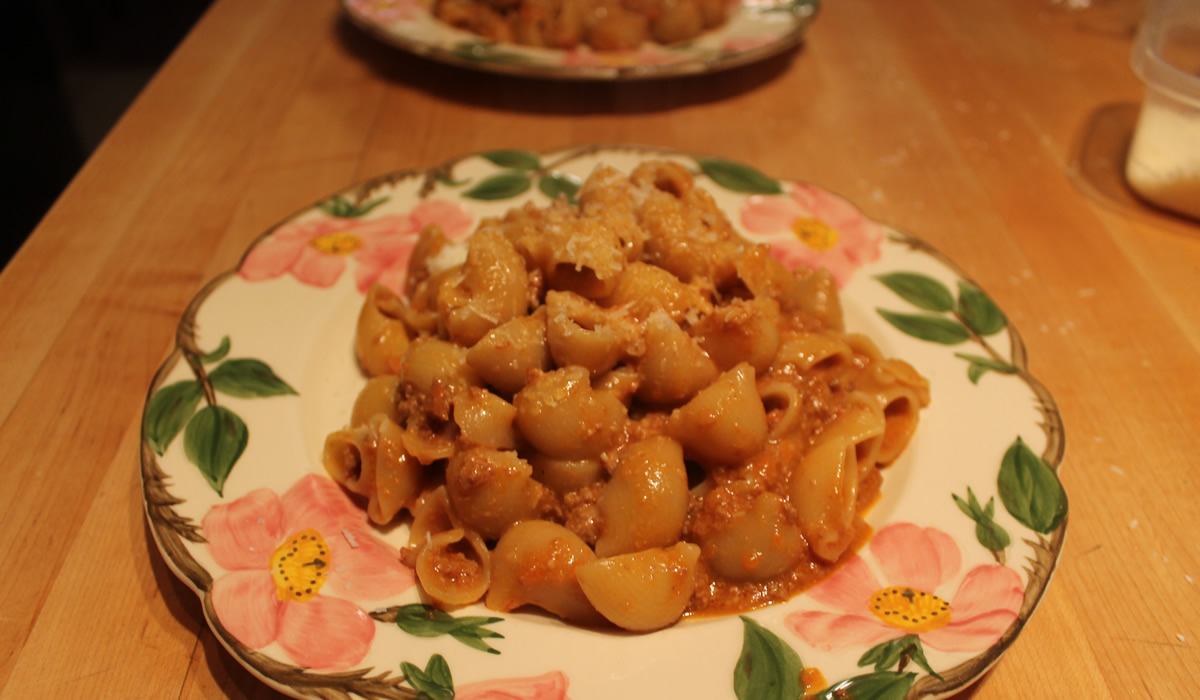We were watching a rerun of one of Lidia’s programs the other night when she started making a Bolognese sauce – with milk. It was one of those “aha” moments – as in we’re going to have to make this really soon.
Really soon translated to a mere two days, and armed with Lidia’s cookbook Lidia’s Family Table, Victor went to work. There are two variations on the ragu – the tradizionale with wine and tomatoes that is the most common, today – and the antica – an older variation that has fallen out of favor. We went for the antica!
The process is interesting… The wine gets poured and worked into the meat before it’s cooked, the pancetta and garlic get processed into a paste – a pestata – and a three hour simmer with additions of hot milk or broth every 20 minutes. It’s a process – but really worth it!
Ragu alla Bolognese – Ricetta Antica
adapted from Lidia’s Family Table
- 1 lb ground beef
- 1 lb ground pork
- 1 cup dry white wine
- 6 ounces pancetta
- 5 large garlic cloves
- 2 tbsp olive oil
- 1 medium onion minced
- 2 celery stalks, minced
- 1 carrot, minced
- 1 can tomato paste
- 2 cups of milk
- freshly grated nutmeg
- 2 large bay leaves
- 2 cups of beef broth
- salt to taste
- freshly ground pepper
Break up and mix together ground beef and pork in a large mixing bowl. Pour over wine and mix in with fingers to ensure it’s evenly moistened.
Make the pestata: Roughly chop pancetta and place in a food processor with peeled garlic. Process into a fine paste.
In a large heavy pan, heat 2 tbsp of olive oil and scrape in the pestata. Place over medium/high heat and break up with a spoon to render the juices.
Once the pestata has started rendering its fat, stir in the minced onion and cook until they start to sweat. Add the minced carrots and celery, stirring until they’re all wilted and golden, about 5 minutes.
Turn the heat up a bit, push the vegetables to the side and add your meat mixture to the pan, giving it a few moments to brown on the bottom of the pan before mixing in with the vegetables. Cook on high heat, stirring frequently, for ab.out 30-45 minutes, until all all of the liquid has disappeared. Begin heating up your liquids (milk, broth) for the next steps.
Once again, push aside your meat/vegetable mixture and create a hole to place the tomato paste so it can lightly cook. Cook for another 2-3 minutes.
Pour in 2 cups of hot milk and stir into the meat mixture, making sure to scrape any brown bits off the bottom of your pan.
Grate the nutmeg into the pan.
Bring the sauce to a slow, steady simmer, consistently bubbling away. Cover and let cook for at least 3hrs, checking and stirring every 20 minutes. Use hot broth to maintain the sauces liquid levels throughout cooking.
To finish the sauce, uncover and allow sauce to simmer into a thicker consistency.
Add salt and pepper to taste.
Serve with your favorite pasta – tagliatelle is the traditional pasta – but use what you like. Top with plenty of freshly grated parmesan.
We used a Pipe Rigate pasta instead of the tagliatelle because Nonna doesn’t do noodles of any sort. I really liked the pipe rigate, though, because the sauce went into the pasta and there were little sauce explosions in my mouth as I chewed.
The entire dish was swoon-worthy!
The recipe made a lot of sauce, so Victor froze half of it for another meal, and even after dishing out three huge portions, there’s enough left for lunch, tomorrow.
We’re planning a side trip to Bologna next year when we’re in Milan – I want to see the huge Eataly complex – and I now want to see if they can make a sauce this good in Italy!

